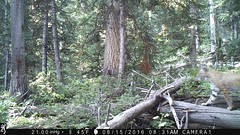Hudson’s Sand Bugger
For a recent bonefishing trip to Andros Island, I took my Hudson’s Mud Bugger fly pattern and turned it into a bonefish fly. It was a total experiment, but it turned out to be an awesome fly. The only problem was that I didn’t tie enough of them. Well, unfortunately, I’m not heading off to another tropical trip anytime soon, but my dad has been spending the fall chasing redfish and speckled trout down in Texas. So, I tied up and sent him a few variations of the Hudson’s Sand Bugger for his Texas flats adventures.
If you’re interested in the carp variation, Hudson’s Mud Bugger, you can find it here – https://unquenchablecuriosity.wordpress.com/2011/08/31/hudsons-mud-bugger/
Is it a shrimp? Is it a crab? Who cares. It’s damn easy to tie. So, let’s get started…
Materials for Hudson’s Sand Bugger:
Hook: Umpqua Tiemco TMC 811S #4-8
Thread: UTC 140, florescent orange or fl. shell pink
Eyes: Large lead dumbbell or bead chain, silver
Tail: Turkey biot quills, hendrickson (also try variations of tan and brown)
Hackle: Whiting Bugger Pack, ghost barred white (also try grizzly brown or a combination of brown and white)
Optional: .025 lead wire for extra weight
Directions:
Step 1: Tie in the eyes directly behind the hook eye leaving only enough room to whip finish at the end. I apply a spot of Zap-A-Gap to solidly anchor the eyes. This is a pretty durable fly, so let’s just make it bomb-proof.
Optional: This fly lands very softly on the surface, but you can play with the sink rate by adding 12-14 twists of 0.25 lead wire to the hook shank. Otherwise, leave off the extra weight as the large eyes are enough for most skinny water applications.
Step 2: Wrap the thread a bit past the bend of the hook, and build a small thread ball. This helps keep the turkey biots splayed out for a consistent presentation.
Step 3: Clip two small sections from the turkey feather. Match them up evenly by the tips and tie onto either side of the hook just in front of the thread ball. The turkey feathers should extend outward past the tie in point approximately 3/4 to a full hook shank length.
Step 4: Pull two feathers from the Bugger Pack that has fibers approximately 1 1/2 to 2x the hook gap. Strip off the fuzzy fibers and tie in just in front of the turkey biots. Wrap the thread all the way up to the eye.
Optional: Experiment with using one feather or two. I definitely use two feathers on a size 4 or 6 hook, but I sometimes just use one feather on a size 8 hook. Your call. Also, try one white feather and one brown. Mix it up because you never know what type of bottom you may be fishing.
Step 5: Palmer the hackle all the way (past the bead chain) up to the eye. I usually make a few wraps around the eyes if I have enough feather left. Anchor the feather down behind the eye and whip-finish.
Step 6: Now it’s time for a haircut. The head-stand effect of this fly is caused by the angle at which the hackle is trimmed. First run your fingers through the fly and get all the fibers sticking straight out. Take your scissors and start cutting as close as you can to the bead chain and eyes. You’ll want to angle your cut at an approximate 30-40 degree angle from the hook shank. After I’m done with the haircut, I’ll usually dab a bit of Hard as Hull head cement on the whip-finish.
That’s it.
What? You expected more?
Now tie them in different colors. Legs and a bit of flash are other easy additions that could be fun, but I’ve found I didn’t really need them.
If this fly works for you, I’d love to hear about it. Leave a comment.
Tags
art Bahamas bass beer bonefish books brook trout brown trout bucket list carp colorado river cutthroat trout cooking drawing drink eggs environment family fly fishing fly pattern fly tying George Leonard Herter german shorthair pointer Grand Canyon Grand Canyon National Park greenback cutthroat trout homebrew horses humor hunting Indian Peaks inspiration iphone kayaking kids landscape moose mountain whitefish mud bugger Norman Maclean painting photography pike quotes quoute rainbow trout reading redfish Rocky Mountain National Park running shag nasty skiing south platte speckled trout trail running training travel trout video winterArchives
- October 2013 (1)
- May 2013 (1)
- February 2013 (5)
- January 2013 (5)
- December 2012 (1)
- October 2012 (1)
- June 2012 (1)
- March 2012 (4)
- February 2012 (1)
- January 2012 (4)
- November 2011 (6)
- October 2011 (6)
- September 2011 (6)
- August 2011 (9)









